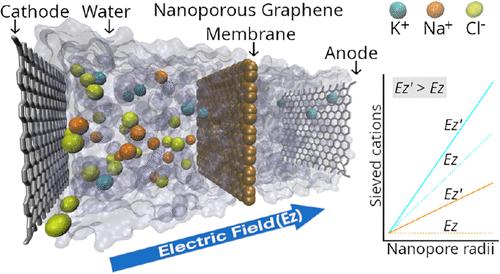亚纳米石墨烯孔离子渗透机制的研究:通过高通量分子模拟揭示自由能垒
IF 16
1区 材料科学
Q1 CHEMISTRY, MULTIDISCIPLINARY
引用次数: 0
摘要
了解离子通过亚纳米石墨烯纳米孔的传输对于推进纳米级过滤技术和揭示选择性离子渗透的分子机制至关重要。由于其原子厚度和可调节的孔径,纳米多孔石墨烯膜可以作为探测空间限制下离子选择性和水化行为的模型系统。本研究研究了Na+、Cl -、K+和水通过石墨烯纳米孔的传输,以阐明它们的离子筛分特性。与离子和水渗透相关的自由能垒被量化,从而深入了解通过纳米孔脱水和转运的能量成本。使用恒电位法(CPM)进一步研究了选择性离子传输,该方法更准确地反映了实验电化学条件,并允许K+在纳米多孔石墨烯膜内选择性渗透Na+。还探讨了外加电场的作用,以评估其对离子水化和输运动力学的影响。总之,这些结果有助于对纳米多孔原子薄膜中离子约束、水合作用和选择渗透的更深层次的机制理解。本文章由计算机程序翻译,如有差异,请以英文原文为准。

Elucidating the Mechanisms of Ion Permeation through Sub-Nanometer Graphene Pores: Uncovering Free Energy Barriers via High-Throughput Molecular Simulations
Understanding ion transport through subnanometer graphene nanopores is critical for advancing nanoscale filtration technologies and uncovering the molecular mechanisms underlying selective ion permeation. Owing to their atomic thickness and tunable pore sizes, nanoporous graphene membranes serve as a model system for probing ion selectivity and hydration behavior under spatial confinement. This work investigates the transport of Na+, Cl–, K+, and water through graphene nanopores to elucidate their ion-sieving characteristics. Free energy barriers associated with ion and water permeation are quantified, offering insight into the energetic costs of dehydration and translocation through nanopores. Selective ion transport is further examined using the constant potential method (CPM), which more accurately reflects experimental electrochemical conditions, and allows for the selective permeation of K+ over Na+ within nanoporous graphene membranes. The role of externally applied electric fields is also explored to assess their impact on ion hydration and transport dynamics. Together, these results contribute to a deeper mechanistic understanding of ion confinement, hydration, and selective permeation in nanoporous atomically thin membranes.
求助全文
通过发布文献求助,成功后即可免费获取论文全文。
去求助
来源期刊

ACS Nano
工程技术-材料科学:综合
CiteScore
26.00
自引率
4.10%
发文量
1627
审稿时长
1.7 months
期刊介绍:
ACS Nano, published monthly, serves as an international forum for comprehensive articles on nanoscience and nanotechnology research at the intersections of chemistry, biology, materials science, physics, and engineering. The journal fosters communication among scientists in these communities, facilitating collaboration, new research opportunities, and advancements through discoveries. ACS Nano covers synthesis, assembly, characterization, theory, and simulation of nanostructures, nanobiotechnology, nanofabrication, methods and tools for nanoscience and nanotechnology, and self- and directed-assembly. Alongside original research articles, it offers thorough reviews, perspectives on cutting-edge research, and discussions envisioning the future of nanoscience and nanotechnology.
 求助内容:
求助内容: 应助结果提醒方式:
应助结果提醒方式:


